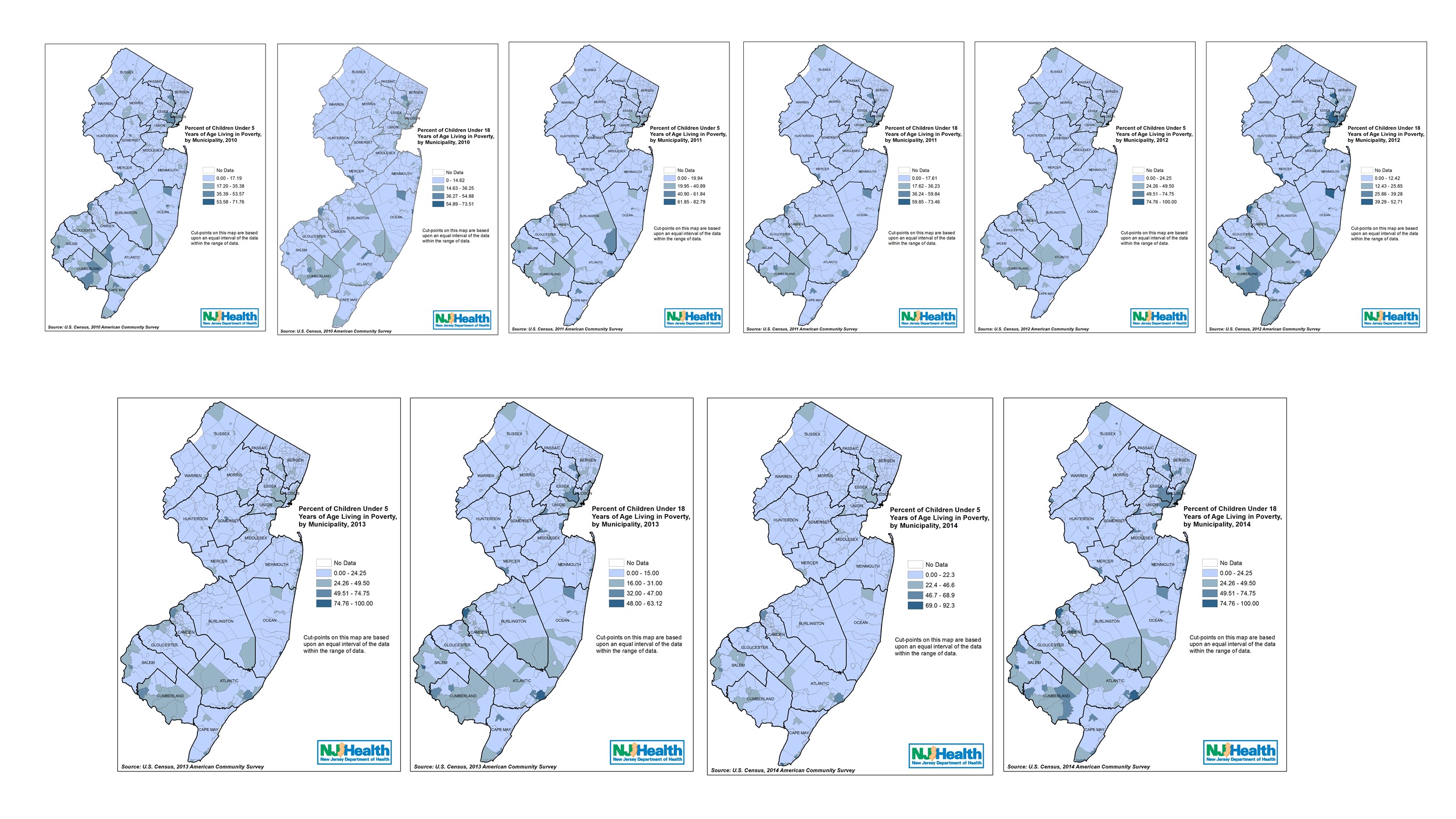Health Indicator Report of Children Under Five Years of Age Living in Poverty
Poverty affects a wide range of resources that can enhance or diminish quality of life and thus have a significant influence on health outcomes. These resources include safe and affordable housing, access to education, public safety, availability of healthy foods, local emergency/health services, and environments free of life-threatening toxins.[https://www.healthypeople.gov/2020/topics-objectives/topic/social-determinants-of-health ^1^]
Time Series Maps:

[https://www-doh.state.nj.us/doh-shad/view/sharedstatic/PovSeries.jpg Close-up of maps]
Data Source
American Community Survey, U.S. Census Bureau, [https://www.census.gov/programs-surveys/acs/]Definition
Number or percent of children under 5 years of age living in povertyNumerator
Number of children less than 5 years of age living in poverty in a geographic areaDenominator
Number of children less than 5 years of age living in a geographic areaHow Are We Doing?
Based upon 2020 American Community Survey 5-year estimates from the U.S. Census data, there were wide variations in the county rates of poverty among New Jersey children less than 5 years of age. Counties with the highest percentages of children under 5 years of age living in poverty were Passaic, Salem, Atlantic and Essex Counties. The lowest percentages of poverty among children less than 5 years were in Hunterdon and Morris Counties. In New Jersey, approximately a quarter of Black and Hispanic children under 5 years of age are living in poverty. The rates for White and Asian children under age 5 are 11.4% and 4.5%, respectively.How Do We Compare With the U.S.?
New Jersey's early childhood poverty rate of 14.2% is below the national rate of 18.7%.Available Services
Links to many services for children are available through the New Jersey Department of Health, [http://nj.gov/health/fhs/index.shtml Division of Family Health Services]. New Jersey's 24/7 Family Health Line can help NJ residents locate a variety of services for New Jersey children. Call 1-800-328-3838. Children without health insurance may be eligible for no cost or low cost insurance through [http://www.njfamilycare.org/ NJ FamilyCare]. For information, call 1-800-701-0710. The New Jersey Department of Human Services, [http://www.state.nj.us/humanservices/dfd/home/index.html Division of Family Development] provides many links to services and programs that assist low income children and their families. These services include: WorkFirst NJ; Temporary Assistance for Needy Families (TANF); child support; emergency assistance; NJ Medicaid; and Food Stamps.Health Program Information
Poverty during childhood puts children at increased risk for living in run-down or poorly maintained older (pre-1950s) housing, and this increases a child's chances of exposure to chipped and peeling lead paint. Deteriorating lead paint (chipping, flaking, and peeling) and paint disturbed during home remodeling contributes to lead dust, contaminates bare soil around a home, and makes paint chips and dust-containing lead accessible. Children are more vulnerable to lead poisoning than adults. The first six years, particularly the first three years of life, is the time when the brain grows the fastest, and when the critical connections in the brain and nervous system are formed. The normal behavior of children at this age - crawling, exploring, teething, putting objects in their mouth - can put them in contact with lead that is present in their environment.
Page Content Updated On 03/24/2022,
Published on 03/24/2022

